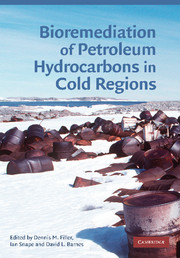Crossref Citations
This Book has been
cited by the following publications. This list is generated based on data provided by Crossref.
Tin, T.
Fleming, Z.L.
Hughes, K.A.
Ainley, D.G.
Convey, P.
Moreno, C.A.
Pfeiffer, S.
Scott, J.
and
Snape, I.
2009.
Impacts of local human activities on the Antarctic environment.
Antarctic Science,
Vol. 21,
Issue. 1,
p.
3.
Filler, Dennis M.
Van Stempvoort, Dale R.
and
Leigh, Mary B.
2009.
Permafrost Soils.
Vol. 16,
Issue. ,
p.
279.
Prince, Roger C.
2009.
Kirk-Othmer Encyclopedia of Chemical Technology.
p.
1.
Margesin, Rosa
and
Feller, Georges
2010.
Biotechnological applications of psychrophiles.
Environmental Technology,
Vol. 31,
Issue. 8-9,
p.
835.
Ulrich, Ania C.
Tappenden, Kristen
Armstrong, James
and
Biggar, Kevin W.
2010.
Effect of cold temperature on the rate of natural attenuation of benzene, toluene, ethylbenzene, and the three isomers of xylene (BTEX).
Canadian Geotechnical Journal,
Vol. 47,
Issue. 5,
p.
516.
Aronson, Richard B.
Thatje, Sven
McClintock, James B.
and
Hughes, Kevin A.
2011.
Anthropogenic impacts on marine ecosystems in Antarctica.
Annals of the New York Academy of Sciences,
Vol. 1223,
Issue. 1,
p.
82.
Braun, Christina
Mustafa, Osama
Nordt, Anja
Pfeiffer, Simone
and
Peter, Hans-Ulrich
2012.
Environmental monitoring and management proposals for the Fildes Region, King George Island, Antarctica.
Polar Research,
Vol. 31,
Issue. 1,
p.
18206.
Zhang, Dechao
and
Margesin, Rosa
2014.
Characterization of culturable heterotrophic bacteria in hydrocarbon-contaminated soil from an alpine former military site.
World Journal of Microbiology and Biotechnology,
Vol. 30,
Issue. 6,
p.
1717.
Hughes, Kevin A.
2014.
Antarctic Terrestrial Microbiology.
p.
263.
Naseri, Masoud
Barabadi, Abbas
and
Barabady, Javad
2014.
Bioremediation treatment of hydrocarbon-contaminated Arctic soils: influencing parameters.
Environmental Science and Pollution Research,
Vol. 21,
Issue. 19,
p.
11250.
Braun, Christina
Hertel, Fritz
Mustafa, Osama
Nordt, Anja
Pfeiffer, Simone
and
Peter, Hans-Ulrich
2014.
Antarctic Futures.
p.
169.
Margesin, Rosa
2014.
Cold-adapted Yeasts.
p.
465.
Filler, D.M.
Kennicutt, Mahlon C.
Snape, Ian
Sweet, Stephen T.
and
Klein, Andrew G.
2014.
Handbook of Oil Spill Science and Technology.
p.
495.
Margesin, Rosa
2014.
Cold-adapted Yeasts.
p.
465.
Camenzuli, Danielle
and
Freidman, Benjamin L.
2015.
On-site and in situ remediation technologies applicable to petroleum hydrocarbon contaminated sites in the Antarctic and Arctic.
Polar Research,
Vol. 34,
Issue. 1,
p.
24492.
Horel, Agota
Schiewer, Silke
and
Misra, Debasmita
2015.
Effect of concentration gradients on biodegradation in bench-scale sand columns with HYDRUS modeling of hydrocarbon transport and degradation.
Environmental Science and Pollution Research,
Vol. 22,
Issue. 17,
p.
13251.
Akbari, Ali
and
Ghoshal, Subhasis
2015.
Effects of diurnal temperature variation on microbial community and petroleum hydrocarbon biodegradation in contaminated soils from a sub‐Arctic site.
Environmental Microbiology,
Vol. 17,
Issue. 12,
p.
4916.
Yang, Sizhong
Wen, Xi
Shi, Yulan
Liebner, Susanne
Jin, Huijun
and
Perfumo, Amedea
2016.
Hydrocarbon degraders establish at the costs of microbial richness, abundance and keystone taxa after crude oil contamination in permafrost environments.
Scientific Reports,
Vol. 6,
Issue. 1,
Nagkirti, Pradnya
Shaikh, Azhar
Vasudevan, Gowdaman
Paliwal, Vasundhara
and
Dhakephalkar, Prashant
2017.
Optimization and Applicability of Bioprocesses.
p.
141.
Maklyuk, Elena
Tsygichko, Ganna
Vilnyy, Ruslan
and
Mojon, Alex
2017.
Soil Science Working for a Living.
p.
275.



